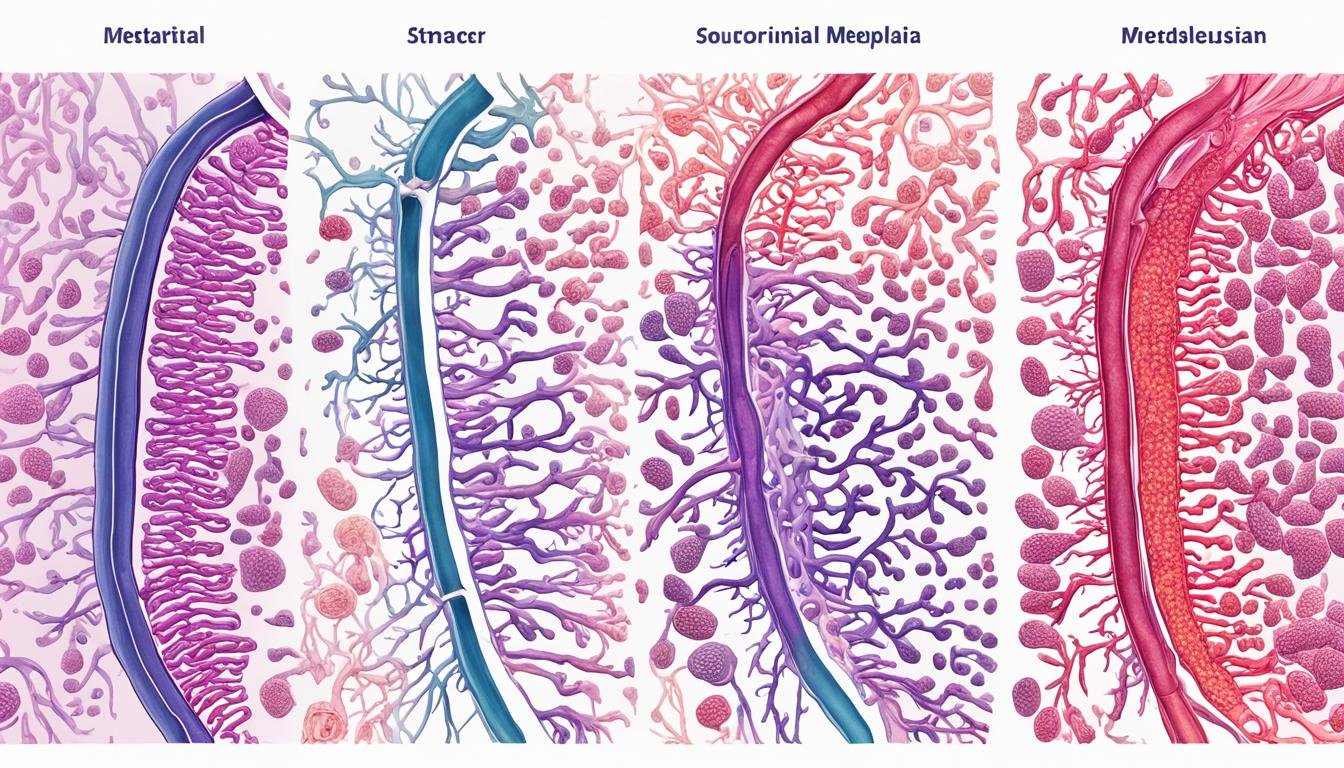Gastric cancer is a serious issue globally, ranking second in cancer deaths. It comes from a series of steps. This starts from gastritis to glandular atrophy, intestinal metaplasia, and then dysplasia. Finally, it leads to cancer.1 IM stands as a step before cancer. It is seen as a precancerous stage. A big cause of this is the Helicobacter pylori infection. It increases the chance of getting gastric cancer by 2-3 times.1 Because cancer takes a long time to develop, checking the benefits of treating H. pylori is hard. Researchers often look at if the pre-cancerous changes, like IM and GA, go away. They can show if the treatment is working.
Key Takeaways
- Gastric cancer often develops through a step-by-step progression from gastritis to intestinal metaplasia, dysplasia, and ultimately, cancer.
- Helicobacter pylori infection is a significant risk factor for gastric cancer, increasing the risk 2-3 times.
- The long timeline for gastric cancer development makes it challenging to assess the benefits of H. pylori eradication in preventing cancer.
- Most studies focus on examining regression of precancerous changes, such as intestinal metaplasia and glandular atrophy, as indicators of successful treatment.
- Regular endoscopic surveillance and monitoring are crucial for early detection and prevention of gastric cancer in individuals with intestinal metaplasia.
Understanding Intestinal Metaplasia
Intestinal metaplasia is a change in the cells in the upper digestive tract. This mainly happens in the stomach or esophagus. The cells start to look more like those in the intestines.2 Usually, it doesn’t cause any symptoms by itself. But, it’s a big change in cells and can lead to cancer.
What is Intestinal Metaplasia?
Barrett’s esophagus is what we call it in the esophagus. When it happens in the stomach, we say it’s gastric intestinal metaplasia.2 This change in cells is a response to long-term irritation. Things like smoking, drinking, constant acid reflux, and a certain infection can start it. Even some autoimmune conditions can do this to the stomach.
Who Does This Condition Affect?
2 People of Hispanic and East Asian backgrounds are more likely to get gastric intestinal metaplasia. On the other hand,2 Barrett’s esophagus happens more in white men.
How Does Intestinal Metaplasia Affect the Body?
Most times, intestinal metaplasia won’t show any symptoms.2 But, it is a big change in how cells look. This change makes them more likely to keep changing in a way that can lead to cancer.
Intestinal Metaplasia and Cancer Risk
Intestinal metaplasia is a2 precancerous condition. It’s a step toward cancer. Cells change and may become cancerous if not stopped.
But, turning into2 stomach or2 esophageal cancer is unlikely. Still, doctors check on it and try to prevent further harm.
Is Intestinal Metaplasia Serious?
Yes, it’s very serious. Cells in your stomach or throat can change to cancer if not treated. This change doesn’t happen quickly, but some things can make it happen faster.
Doctors watch closely and help stop it from getting worse. They use tests and advice on how to stay healthy.
| Condition | Annual Incidence of Gastric Cancer |
|---|---|
| Gastric Intestinal Metaplasia (GIM) | 0.25%3 |
| Mild-to-Moderate Dysplasia | 0.6%3 |
| Severe Dysplasia | 6%3 |
The Correa cascade explains how3 precancerous changes can lead to stomach cancer. More serious changes make cancer more likely. Studies show the danger is real for those with severe changes.
But, doctors are on top of it. They work hard to keep people safe from stomach or throat cancer. They do this with checks, advice, and sometimes special care.
Types of Gastric Intestinal Metaplasia
Gastric intestinal metaplasia, or IM, has types based on change degree and location. It’s either focal, in a small area, or extensive, in many areas of the stomach. The extensive type is more likely to lead to cancer.2
Categorization Based on Cellular Transformation
IM changes the stomach cells to those like the small or large intestine cells. This process is called cellular transformation, and there are two types. If cells look mostly like the small intestine’s, it’s complete (Type I). If they’re more like the colon’s, it’s incomplete (Type II and Type III).2 The incomplete type is seen as more advanced and can lead to dysplasia.2
| Type of Intestinal Metaplasia | Cellular Characteristics | Cancer Risk |
|---|---|---|
| Complete (Type I) | Cells resemble small intestine | Lower risk |
| Incomplete (Type II and III) | Cells resemble large intestine (colon) | Higher risk |
Extensive and incomplete IM are advanced stages. They pose a higher risk of turning into dysplasia and then gastric cancer.21

Stages of Intestinal Metaplasia Progression
Intestinal metaplasia goes through different stages with more cell changes. The first stage is low-grade dysplasia. Some cells start to look different but not aggressively.2
Low-Grade Dysplasia
Low-grade dysplasia means cells look slightly changed. They’re not fully abnormal. Doctors keep a close eye on this stage. They want to stop cancer from forming.2
High-Grade Dysplasia
High-grade dysplasia comes next, with cells looking even more different. They might branch out. But, they haven’t turn into cancer yet. This stage is closer to cancer.2 Doctors could suggest getting treated. This helps stop cancer from growing.
In high-grade dysplasia, cells have very changed looks. This is almost cancer.2 Type I changes make it seem like the small intestine. Type II changes make it look more like the large intestine and are seen as later stage signs.
| Precancerous Stage | Key Characteristics |
|---|---|
| Low-Grade Dysplasia | Some architectural changes, but cells not highly abnormal or invasive |
| High-Grade Dysplasia | Complex architectural changes, including branching and budding, but not yet invasive |
Some people might have focal intestinal metaplasia. This means it’s only in a small part of the stomach. But when it’s more widespread, called extensive IM, things can get serious.2
Epidemiology and Prevalence
It’s hard to know how many people have intestinal metaplasia as it shows no direct symptoms. But, through testing, we see it’s between 3% and 20% in America.4 More people of Hispanic and East Asian background have it. For white men, Barrett’s esophagus is more common. This is a form of intestinal metaplasia in the esophagus.
How Common is Intestinal Metaplasia?
Before and after getting rid of Helicobacter pylori, you can still get gastric atrophy or intestinal metaplasia.4 A study found that H. pylori can lead to these conditions. For gastric cancer, people in the southwest USA showed a mix of risks.4 One study has shown a link between stomach intestinal metaplasia and gastric cancer.4 The AGA technical review also talked about the risks of gastric intestinal metaplasia and its related factors.4
For those without any changes in their stomach linings, the yearly risk of getting gastric cancer is low. But for those with even minor changes, this risk goes up.5 As the stomach changes get more serious, the risk climbs. Dysplasia, a more advanced stage, has the highest risk.5 About 1 in 256 with normal stomach lining, 1 in 85 with gastritis, 1 in 50 with atrophic gastritis, 1 in 39 with intestinal metaplasia, and 1 in 19 with dysplasia get gastric cancer within 20 years.5 Gastric cancer rates have dropped in Sweden since 1940. But, atrophic gastritis is going up among people aged 35 to 44. This might slowly increase gastric cancer cases again.5 A Swedish study looked at over 400,000 people who had stomach biopsies done. They checked from 1979 to 2011 for reasons other than cancer.5
Risk Factors for Intestinal Metaplasia Progression
Helicobacter pylori infection is a top risk for intestinal metaplasia’s growth. It eats away the stomach’s protective layer. This leads to metaplasia.23 Being over 45 adds to this risk.1
Smoking, alcohol use, and chronic acid reflux (GERD) help metaplasia grow.21 Also, autoimmune issues can make someone more likely to get stomach metaplasia.2
Helicobacter Pylori Infection
More than 90% of chronic gastritis cases come from Helicobacter pylori infection. It’s pretty common in the U.S., too.3 Having the bacteria for a long time is liked to getting stomach metaplasia.213
Age
People over 45 are more at risk of their metaplasia growing.1
Lifestyle Factors
Smoking, alcohol use, and chronic acid reflux (GERD) can lead to metaplasia.21
Autoimmune issues can boost the risk too.2
How Long Does It Take for Intestinal Metaplasia to Turn Into Cancer?
Progression Timeline
The time it takes for intestinal metaplasia to turn into cancer varies. It might take several years or even decades. This is to say, it’s a slow process for some people.1 But, it can speed up due to different reasons. These include how severe the metaplasia is, if there’s a Helicobacter pylori infection, your age, and habits like smoking and drinking.1
Individual Variations
Doctors keep a close eye on those with intestinal metaplasia. They judge the risk of it turning into cancer for each person. The risk time can change based on some things. For example, a bigger area of metaplasia in your stomach makes cancer more likely.2 Also, not all types of metaplasia are the same. Incomplete metaplasia (Type II) poses a higher risk of becoming cancer than complete metaplasia (Type I).2
Endoscopic Surveillance and Monitoring
Having intestinal metaplasia raises cancer risk. That’s why getting endoscopic screening and having regular surveillance is very important.4 During an endoscopy, a doctor can check the throat and stomach’s inner lining. They can take small samples, called biopsies, to see if changes are happening.4 Doing this checks for precancerous changes early. It helps stop cancer from forming.4
Importance of Regular Screening
Various groups, like the European Society of Gastrointestinal Endoscopy, say checking and treating early can stop stomach cancer. They call it a good way to lower cancer numbers without spending a lot.4 The American Gastroenterological Association adds that looking out for gastric intestinal metaplasia through regular check-ups is very key. This helps manage it before it becomes a problem.
Recommended Frequency of Surveillance
So, how often should you get checked? For most, every 3-5 years is fine. Still, those with heavy or advanced metaplasia will need more checks.46 A 2019 notice from the British Society of Gastroenterology looked at all the facts. It made recommendations for those at risk of stomach cancer.6
| Condition | Recommended Surveillance Frequency |
|---|---|
| Intestinal Metaplasia | Every 3-5 years |
| Extensive or Advanced Metaplasia | More Frequent Monitoring |
Prevention Strategies for Gastric Cancer
To stop intestinal metaplasia from turning into gastric cancer, doctors look at two big things. They work on getting rid of Helicobacter pylori, and they help people change their diets and lives. Killing off the H. pylori bug helps a lot because it’s usually the main reason for stomach cancer. It can make early warning signs like intestinal metaplasia get better or even go away.4
Helicobacter Pylori Eradication
H. pylori makes up to 89% of the stomach cancer cases worldwide.7 This bug can harm the stomach’s protective layer, causing intestinal metaplasia.4 Getting rid of H. pylori has been found to make things better for people with stomach problems or signs of future cancer.4 A study also showed that these early signs could improve just a year after treating an H. pylori infection.4
Dietary and Lifestyle Modifications
Cutting out H. pylori is a big step, but changing what we eat and how we live also matters. Eating more fruits and veggies and less smoked or salty foods is good.3 So is stopping smoking and drinking less alcohol. These changes can slow down or stop the path to stomach cancer.3
Doctors use both of these big steps to fight stomach cancer. They want to help people with intestinal metaplasia and lower their chance of getting stomach cancer.
Treatment Options for Intestinal Metaplasia
If you have intestinal metaplasia, doctors look at many ways to treat it. This can stop it from becoming cancer. They often use endoscopic resection or pharmacological interventions.
Endoscopic Resection
Endoscopic resection is a simple procedure. It works well if the metaplasia is only in one spot. Doctors remove the bad lining in the esophagus or stomach. This stops the cells from growing into cancers.8
Pharmacological Interventions
Doctors sometimes also use medicines. These drugs treat issues like acid reflux or infections. They can use things like proton pump inhibitors to help. These are problems that often lead to metaplasia.9
Their main aim is to keep metaplasia from getting worse. They want to stop cancer before it starts. With both kinds of treatments, the chances of getting cancer are lower.
Future Directions and Research
Ongoing research is looking at better ways to find and handle intestinal metaplasia. Doctors hope to find biomarkers early, like special signs on a person’s genes. This could help spot those who might get cancer in their stomach or throat. Then, doctors could watch these people closer and help them sooner.2
Doctors are also trying new therapeutic approaches. They’re looking at new drugs, immune treatments, and ways to treat each person specially. They want to stop or turn back the growth of intestinal metaplasia better.10
Looking ahead, more work is being done to help doctors do better at finding and stopping this before it turns into cancer. The goal is to lower the number of people who get cancer in their throat or stomach.2
Conclusion
Intestinal metaplasia is a risky condition that may result in stomach or throat cancer. It can take a long time to develop into cancer. But things like a bacteria infection called Helicobacter pylori1, age1, and health choices1 can speed it up.4
Getting regular check-ups and watching your health closely is very important. This includes getting rid of the H. pylori bacteria4. It also means changing your diet and how you live. Doing these things helps lower the risk of cancer.1 Researchers are looking into ways to find this condition early and treat it better. Their goal is to stop intestinal metaplasia from turning into cancer.
Knowing about intestinal metaplasia and ways to deal with it is key. It can help lessen the risk of getting stomach or throat cancer. Doctors and others in healthcare are working hard on this. They want to help people stay healthy, especially those who are more likely to get these types of cancer.4
FAQ
What is intestinal metaplasia?
Who does this condition affect?
How does intestinal metaplasia affect the body?
Is intestinal metaplasia serious?
How is gastric intestinal metaplasia categorized?
What are the stages of intestinal metaplasia progression?
How common is intestinal metaplasia?
What are the risk factors for the progression of intestinal metaplasia?
How long does it take for intestinal metaplasia to turn into cancer?
Why is regular endoscopic surveillance important for individuals with intestinal metaplasia?
How can the progression of intestinal metaplasia to gastric cancer be prevented?
What treatment options are available for individuals with intestinal metaplasia?
What are the future directions and research in the field of intestinal metaplasia?
Source Links
- https://www.ncbi.nlm.nih.gov/pmc/articles/PMC1774213/
- https://my.clevelandclinic.org/health/diseases/22215-intestinal-metaplasia
- https://www.ccjm.org/content/91/1/33
- https://www.ncbi.nlm.nih.gov/pmc/articles/PMC8589342/
- https://www.ncbi.nlm.nih.gov/pmc/articles/PMC4516137/
- https://www.ncbi.nlm.nih.gov/pmc/articles/PMC7364865/
- https://www.ncbi.nlm.nih.gov/pmc/articles/PMC4260094/
- https://www.ncbi.nlm.nih.gov/pmc/articles/PMC7411557/
- https://www.verywellhealth.com/intestinal-metaplasia-4797929
- https://www.ncbi.nlm.nih.gov/pmc/articles/PMC6860040/




